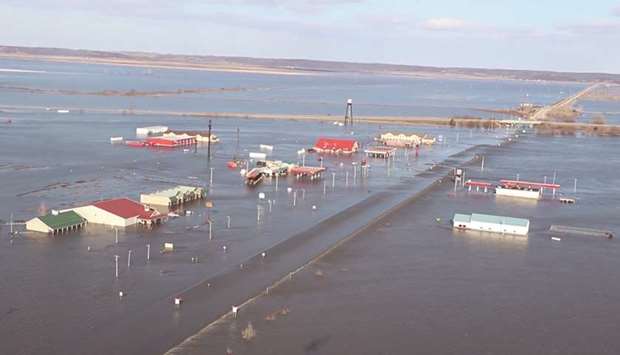As icy, lethal floodwaters fed by rains and melting snow recede in Nebraska and Iowa, leaving destroyed homes, drowned cattle and swamped farmland, Midwest states downstream were yesterday setting up for a relentless surge of the Missouri River.
Flooding from last week’s storm has already caused nearly $1.5bn in damage in Nebraska, killed at least four people with another missing.
“This isn’t over,” said David Roth, a meteorologist with the National Weather Service’s Weather Prediction Center.
“The river will have several more major crests through next week,” he said, not counting the numerous tributaries that feed into the Missouri up and down the Midwest and will likely inundate communities into next month.
Ed Clark, director of the National Oceanic and Atmospheric Administration’s (NOAA) National Water Center in Tuscaloosa, Alabama, said the flooding of the past two weeks “will continue through May and become more dire and may be exacerbated in the coming weeks as the water flows downstream.”
“This is shaping up to be a potentially unprecedented flood season, with more than 200mn people at risk for flooding in their communities,” Clark said in NOAA’s outlook for spring.
The waters have already swamped a large swath of Missouri, Nebraska and Iowa along one of North America’s longest rivers.
A state of emergency has been declared in all or parts of the three Midwestern farm states.
“We’re going to get some moderate rain this weekend over eastern Nebraska, maybe a half inch (1.3cm),” Roth said.
“It doesn’t sound like much, but any more precipitation is bad.”
The Missouri River’s next major flood crest is forecast to hit St Joseph, Missouri, at 6am CDT today and a day later in Kansas City, Missouri, 90km to the south, according to the US Army Corps of Engineers.
“Where the Missouri meets the Mississippi River in St Charles, (Missouri,) it has already peaked, but it’s going to crest again early next week,” meteorologist Roth said.
Howard Geib, 54, owns a farm near the town of Craig in Holt County, Missouri, which issued a mandatory evacuation on Wednesday.
Geib said a levee near his farm broke at the weekend, and he saw at least 10 levees in the county that have broken. “They broke,” Geib said. “There are 600-, 700-, 1,000-foot-long holes in the levees.”
More than 2,400 Nebraska homes and businesses have been destroyed or damaged, with 320km of roads unusable and 11 bridges wiped out, Governor Pete Ricketts said on Wednesday.
Ricketts estimated the floods caused at least $439mn in damage to public infrastructure and other assets, and $85mn to privately owned assets.
He put flood damage for the state’s agricultural sector at nearly $1bn.
Offutt Air Force Base near Omaha, which houses the US Strategic Command, whose mission includes defending against and responding to nuclear attacks, remained heavily flooded but operational, officials have said.
Outside Omaha, Pete Smock, 42, worked to clear deep mud surrounding his home and construction business in Valley, Nebraska, in what will be a long cleanup for the region.
“Devastation is everywhere. I haven’t seen anything like this in my lifetime,” Smock said.

A view of flooded areas near Nebraska City.
